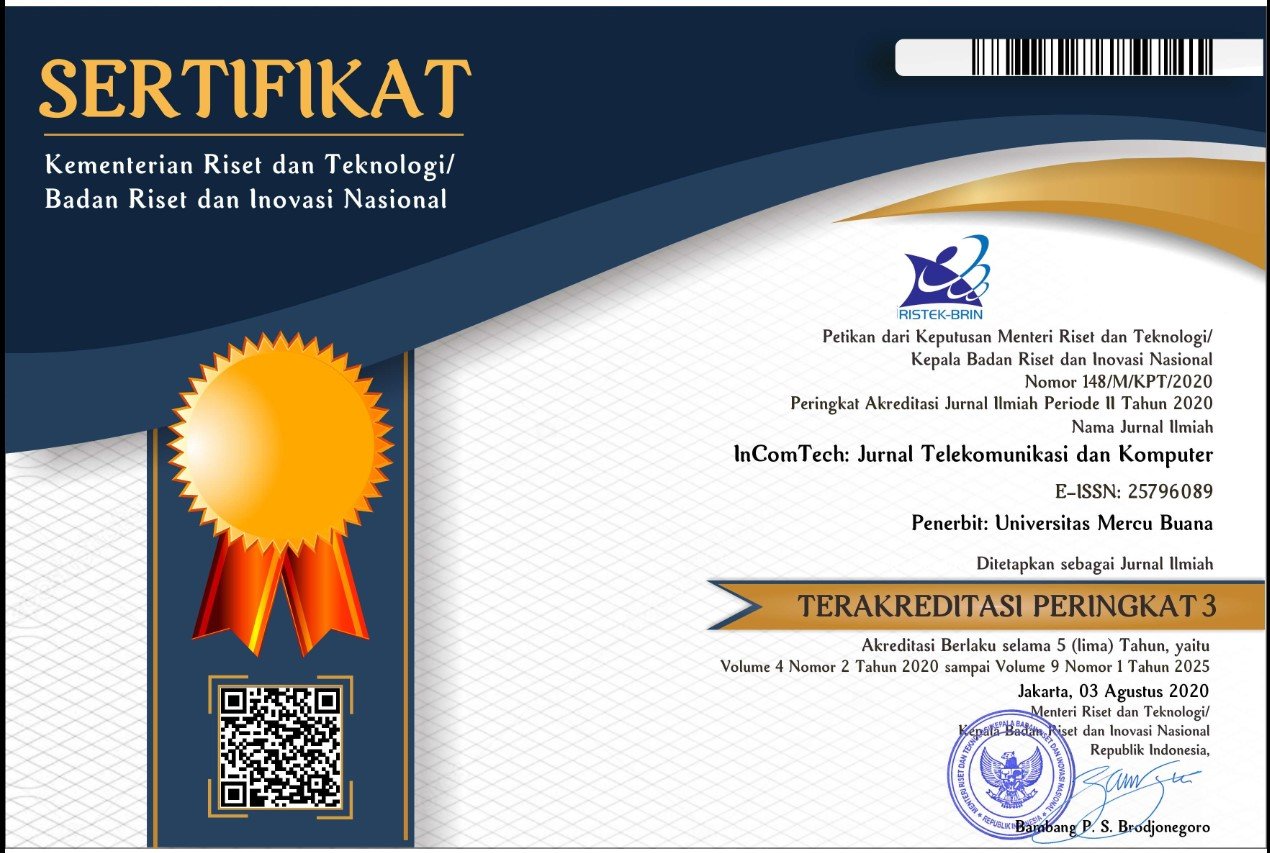Perbandingan Algoritma Decision tree dan Gradient Boosting pada Model Sistem Deteksi Serangan Siber di Jaringan Internet of Things
Abstract
Internet of things (IoT) memberikan banyak manfaat dimana membuat banyak perangkat pintar semakin dekat dan mudah digunakan. Penerapan teknologi IoT yang semakin luas memberikan banyak ancaman bari dalam segi keamanan data karena banyak perangkat yang terhubung dengan protocol yang beragam untuk mengatasinya dibutuhkan sebuah Intrusion Detection System (IDS) yang handal untuk mendeteksi serangan dalam jaringan IoT. Dalam penelitian ini akan membangun sebuah model IDS menggunakan algoritma decision tree dan gradient boosting kemudian membandingkan performanya. Dataset yang digunakan pada penelitian ini menggunakan dataset dari CICIoT2023 karena kelas yang tidak seimbang dan ukuran dataset yang besar teknik Random Under Sampling (RUS) digunakan juga dalam penelitian ini. Hasil dari penelitian menunjukkan performa yang baik untuk setiap model IDS yang dibuat. Untuk data latih ketika tanpa menggunakan maupun teknik RUS algoritma decision tree mendapatkan akurasi tinggi mencapai 100% namun ketika menggunakan data uji gradient boosting mendapatkan hasil yang lebih baik yaitu 99,10% untuk sebelum penerapan teknik RUS dan 76,31% setelah penerapan teknik RUS.
Keywords
Full Text:
PDFReferences
F. Ahamed and F. Farid, “Applying internet of things and machine-learning for personalized healthcare: Issues and challenges,” Proc. - Int. Conf. Mach. Learn. Data Eng. iCMLDE 2018, pp. 22–29, 2019, doi: 10.1109/iCMLDE.2018.00014.
A. Khanna and S. Kaur, “Evolution of Internet of Things (IoT) and its significant impact in the field of Precision Agriculture,” Comput. Electron. Agric., vol. 157, no. December 2018, pp. 218–231, 2019, doi: 10.1016/j.compag.2018.12.039.
F. B. Setiawan and Magfirawaty, “Securing Data Communication Through MQTT Protocol with AES-256 Encryption Algorithm CBC Mode on ESP32-Based Smart Homes,” 2021 Int. Conf. Comput. Syst. Inf. Technol. Electr. Eng. COSITE 2021, no. October, pp. 166–170, 2021, doi: 10.1109/COSITE52651.2021.9649577.
M. Ibrahim and B. Sugiarto, “Rancang Bangun Rumah Pintar (Smart Home) Berbasis Internet Of Things (IoT),” Infotek J. Inform. dan Teknol., vol. 6, no. 1, pp. 1–10, 2023, doi: 10.29408/jit.v6i1.5365.
H. Ahmetoglu and R. Das, “A comprehensive review on detection of cyber-attacks: Data sets, methods, challenges, and future research directions,” Internet of Things (Netherlands), vol. 20, no. September, p. 100615, 2022, doi: 10.1016/j.iot.2022.100615.
A. J. Hintaw, S. Manickam, S. Karuppayah, M. A. Aladaileh, M. F. Aboalmaaly, and S. U. A. Laghari, “A Robust Security Scheme Based on Enhanced Symmetric Algorithm for MQTT in the Internet of Things,” IEEE Access, vol. 11, no. May, pp. 43019–43040, 2023, doi: 10.1109/ACCESS.2023.3267718.
M. Picone, S. Cirani, and L. Veltri, “Blockchain security and privacy for the internet of things,” Sensors (Switzerland), vol. 21, no. 3, pp. 1–4, 2021, doi: 10.3390/s21030892.
E. C. P. Neto, S. Dadkhah, R. Ferreira, A. Zohourian, R. Lu, and A. A. Ghorbani, “CICIoT2023: A Real-Time Dataset and Benchmark for Large-Scale Attacks in IoT Environment,” Sensors, vol. 23, no. 13, p. 5941, 2023, doi: 10.3390/s23135941.
N. Gupta, V. Jindal, and P. Bedi, “LIO-IDS: Handling class imbalance using LSTM and improved one-vs-one technique in intrusion detection system,” Comput. Networks, vol. 192, no. March, pp. 1–19, 2021, doi: 10.1016/j.comnet.2021.108076.
P. I. priyadarsini, ABC-BSRF: Artificial Bee Colony and Borderline-SMOTE RF Algorithm for Intrusion Detection System on Data Imbalanced Problem, vol. 56. Springer Singapore, 2021. doi: 10.1007/978-981-15-8767-2_2.
H. Shafique, A. A. Shah, M. A. Qureshi, and M. K. Ehsan, “Machine Learning Empowered Efficient Intrusion Detection Framework,” VFAST Trans. Softw. Eng., vol. 10, no. 2, pp. 27–35, 2022, doi: http://dx.doi.org/10.21015/vtse.v10i2.1017.
M. Artur, “Review the performance of the Bernoulli Naïve Bayes Classifier in Intrusion Detection Systems using Recursive Feature Elimination with Cross-validated selection of the best number of features,” Procedia Comput. Sci., vol. 190, no. 2019, pp. 564–570, 2021, doi: 10.1016/j.procs.2021.06.066.
B. Charbuty and A. Abdulazeez, “Classification Based on Decision Tree Algorithm for Machine Learning,” J. Appl. Sci. Technol. Trends, vol. 2, no. 01, pp. 20–28, 2021, doi: 10.38094/jastt20165.
S. Rahman, M. Irfan, M. Raza, K. M. Ghori, S. Yaqoob, and M. Awais, “Performance analysis of boosting classifiers in recognizing activities of daily living,” Int. J. Environ. Res. Public Health, vol. 17, no. 3, 2020, doi: 10.3390/ijerph17031082.
R. Zuech, J. Hancock, and T. M. Khoshgoftaar, “Detecting web attacks using random undersampling and ensemble learners,” J. Big Data, vol. 8, no. 1, 2021, doi: 10.1186/s40537-021-00460-8.
A. Divekar, M. Parekh, V. Savla, R. Mishra, and M. Shirole, “Benchmarking datasets for Anomaly-based Network Intrusion Detection: KDD CUP 99 alternatives,” Proc. 2018 IEEE 3rd Int. Conf. Comput. Commun. Secur. ICCCS 2018, pp. 1–8, 2018, doi: 10.1109/CCCS.2018.8586840.
M. Alshamkhany, W. Alshamkhany, M. Mansour, M. Khan, S. Dhou, and F. Aloul, “Botnet Attack Detection using Machine Learning,” Proc. 2020 14th Int. Conf. Innov. Inf. Technol. IIT 2020, pp. 203–208, 2020, doi: 10.1109/IIT50501.2020.9299061.
K. Alissa, T. Alyas, K. Zafar, Q. Abbas, N. Tabassum, and S. Sakib, “Botnet Attack Detection in IoT Using Machine Learning,” Comput. Intell. Neurosci., vol. 2022, 2022, doi: 10.1155/2022/4515642.
D. Upadhyay, J. Manero, M. Zaman, and S. Sampalli, “Gradient Boosting Feature Selection With Machine Learning Classifiers for Intrusion Detection on Power Grids,” IEEE Trans. Netw. Serv. Manag., vol. 18, no. 1, pp. 1104–1116, 2021.
B. A. Tama and K. H. Rhee, “An in-depth experimental study of anomaly detection using gradient boosted machine,” Neural Comput. Appl., vol. 31, no. 4, pp. 955–965, 2019, doi: 10.1007/s00521-017-3128-z.
M. A. S. Arifin, D. Stiawan, and B. Y. Suprapto, “Oversampling and undersampling for intrusion detection system in the supervisory control and data acquisition IEC 60870 ‐ 5 ‐ 104,” IET Cyber‐Physical Syst. Theory Appl., no. November 2023, 2024, doi: 10.1049/cps2.12085.
Y. Hamid, F. A. Shah, and M. Sugumaran, “Wavelet neural network model for network intrusion detection system,” Int. J. Inf. Technol., vol. 11, no. 2, pp. 251–263, 2018, doi: 10.1007/s41870-018-0225-x.
S. Shaikh, S. M. Daudpota, A. S. Imran, and Z. Kastrati, “Towards improved classification accuracy on highly imbalanced text dataset using deep neural language models,” Appl. Sci., vol. 11, no. 2, pp. 1–20, 2021, doi: 10.3390/app11020869.
DOI: http://dx.doi.org/10.22441/incomtech.v15i1.26096

This work is licensed under a Creative Commons Attribution-NonCommercial 4.0 International License.
Publisher Address:
Magister Teknik Elektro, Universitas Mercu Buana
Jl. Meruya Selatan 1, Jakarta 11650
Phone (021) 31935454/ 31934474
Fax (021) 31934474
Email: [email protected]
Website of Master Program in Electrical Engineering
http://mte.pasca.mercubuana.ac.id
pISSN: 2085-4811
eISSN: 2579-6089
Jurnal URL: http://publikasi.mercubuana.ac.id/index.php/Incomtech
Jurnal DOI: 10.22441/incomtech

Ciptaan disebarluaskan di bawah Lisensi Creative Commons Atribusi-NonKomersial 4.0 Internasional
The Journal is Indexed and Journal List Title by:













